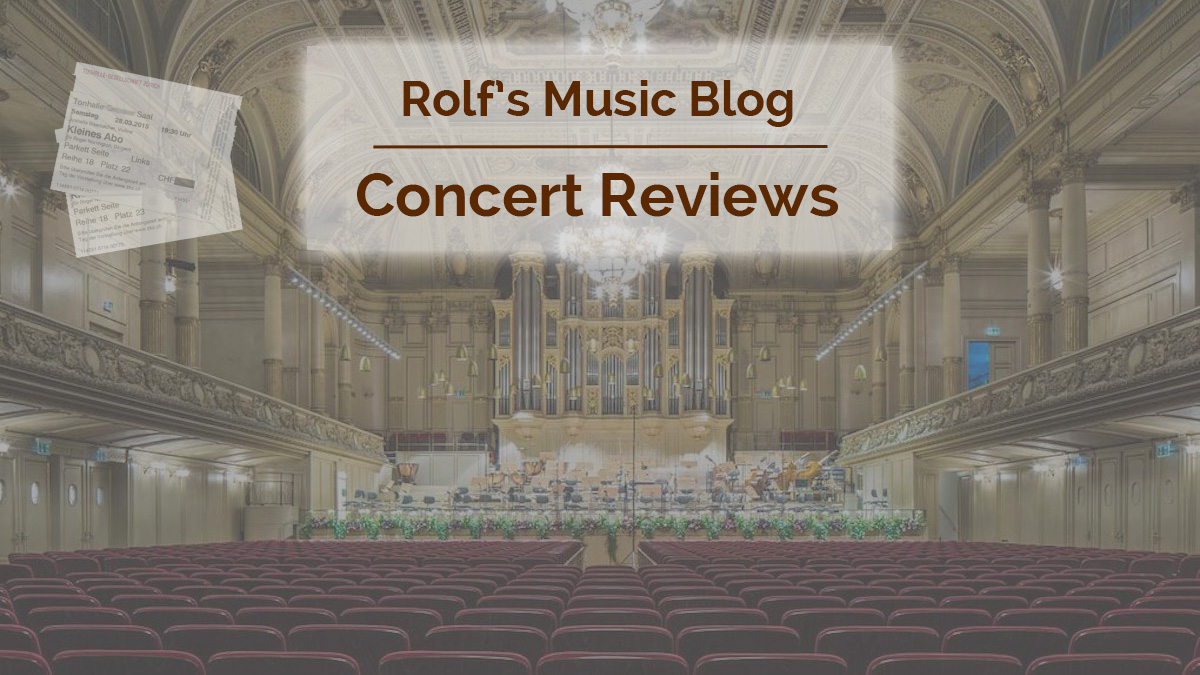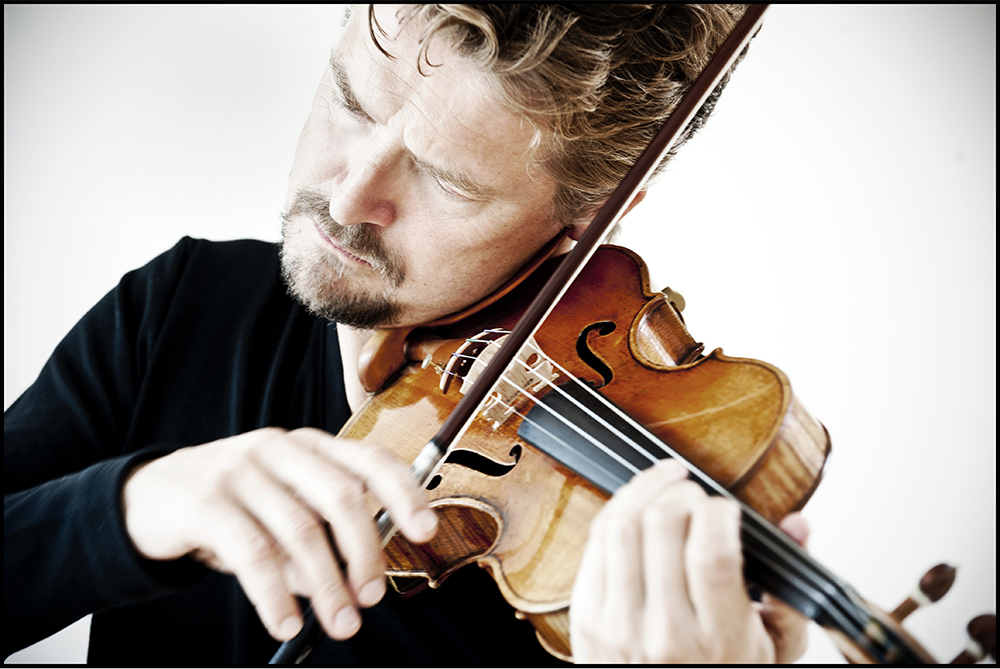Christian Tetzlaff, Sir Roger Norrington / Zurich Chamber Orchestra
Mendelssohn / Beethoven
Tonhalle Zurich, 2017-02-28

2017-03-03 — Original posting
Table of Contents
Introduction
Conductor, Orchestra
The Zurich Chamber Orchestra (Zürcher Kammerorchester, ZKO) gave this concert in the big hall of the Tonhalle in Zurich. The hall was nearly sold out. The audience gave a warm welcome when the orchestra’s Lifetime Honorary Conductor Sir Roger Norrington (*1934), entered the podium, together with the soloist. For Sir Roger, this almost certainly was the last performance in this hall, prior to the upcoming 3-year closure for a thorough renovation. I wonder what went through the conductor’s mind, when he turned around in his conductor chair, looking around with a pleasurable, slightly ironic, if not mocking smile! He held back his explanations, saved them for the symphony, after the intermission.
Christian Tetzlaff
It’s almost exactly 5 years ago, since I first heard Christian Tetzlaff (*1966) in a live performance. This was with exactly the same composition, Mendelssohn’s violin concerto in E minor, op.64. And it was at the very same location, at the Tonhalle in Zurich—but with the Tonhalle Orchestra, and with Ton Koopman as guest conductor.
I was interested in Christian Tetzlaff as violinist (more information on this violinist can be found on Wikipedia). But I was equally interested in hearing the sound of his instrument. Christian Tetzlaff is one of a few international violinists who do not play an old Italian instrument (Amati, Stradivarius, Guarneri, Guadagnini, etc.). His violin was created by Stefan-Peter Greiner, now in London. These violins are known to be absolutely competitive with historic Italian instruments.
Impressions from 2012
My impression from that concert in 2012 seemed to confirm that notion: I found the violin to be full-sounding, the tone to be warm, particularly in the lower register, comparable to old instruments in the overall quality (this was from a parquet seat in the front half of the hall). I found Christian Tetzlaff’s interpretation to be good, maybe excellent, probably above average. However, I had a hard time to find aspects that felt outstanding or special. To me, it was too close to “conventional” performances, and I did not see a distinctly personal note / aspect. And I was not surprised to come to the same conclusion when I compared Christian Tetzlaff’s 2008 CD recording of that concerto (featuring Paavo Järvi conducting the Radio Symphony Orchestra Frankfurt) with other recordings.
A New Chance
Despite these findings and experiences, I decided to re-listen to Christian Tetzlaff’s interpretation now, in 2017. I was curious to hear whether his view on the concerto changed over the past 5 years. Plus, more importantly, this time he would be accompanied by a conductor who, together with the ZKO, was knows to stick to his uncompromising views in the area of historically informed performances of works from the classical and early romantic period. Norrington would not let his performances, his musical views be influenced by traditions that emerged after Mendelssohn’s death, and even more so in the first half of the 20th century.
I’d rather expect Norrington and “his” (former) ensemble to take the pleasure to “brush the music against the grain”. With this conductor, however, this never happens as self-purpose or self-fulfilling prophecy. Rather, it is the result of serious, sincere and thorough research, with the aim to allow the audience to witness the performance similar to how listeners at the composer’s time may have experienced the music. I was hoping that this influence would positively influence also Christian Tetzlaff’s performance. How happy I was about attending this concert in the aftermath!
Mendelssohn: Violin Concerto in E minor, op.64
Felix Mendelssohn Bartholdy (1809 – 1847) completed his Violin Concerto in E minor, op.64 in 1845. I have posted some notes on the creation of this concerto in an earlier post and will not repeat this here. I’m just giving a list of the movements in the concerto:
- Allegro molto appassionato (2/2)
- Andante (6/8)
- Allegretto non troppo (4/4) – Allegro molto vivace (4/4)
The Performance
Certainly, Sir Roger Norrington’s contribution was key to this performance. Yet, the solo part dominates this concerto is almost entirely. The fact that the conductor stayed seated in his turning chair appeared to be confirm this latter impression. He only seemed to supervise loosely, setting key accents every here and there. Of course, the bulk of the conductor’s work is in the preparation, and hence happens in the rehearsals—in this case of course in coordination with the soloist. On top of that, Sir Roger is thoroughly familiar with the members of the ensemble. Plus, during the performance, Willi Zimmermann, the orchestra’s active, very attentive concertmaster was an invaluable help to the conductor.
Some of this may sound like a “routine performance” (even though maybe not the usual routine). However, what I experienced in this concert was definitely anything but routine: it was extraordinary, out-of-the-ordinary in almost all aspects!
I. Allegro molto appassionato
Already the first bars startled with a tempo that was clearly faster than usual, faster than expected. Even more startling: the solo part, which enters the score already in bar #2. The solo part was not just lyrically flowing (like the water in a vivid brooklet); later, in the vivid, more virtuosic sections, it did not exhibit the permanent, relentless, and often hollow business, as often heard (also in the piano concertos). Anything but this! Here, the music was impulsive, full of force, dramatic even. The orchestra exhibited clear, sharp contours, e.g., in the unusual pungency of the flutes in ff notes, plus, of course, in the strong presence of the drums (using sticks with wooden heads).
The Sound that Christian Tetzlaff evoked from his Greiner Instrument was as rounded and projecting as I remembered it from 5 years ago. However, this time, Tetzlaff played with extremely vivid, “speaking” articulation, with lively phrasing, boiling with drama and expression. I barely recognized the music (in comparison to conventional performances, at least). This vivacity was also mirrored in the soloist’s body language, his gestures, how he often turned towards the conductor or the orchestra. As expected, also the cadenza was unusually vivid and expressive—a coherent performance throughout.
(Orchestra)
The wind instruments were standing, on both sides of the string instruments. Flutes and oboes on the left, clarinets and bassoons on the right, brass instruments in the rear. This allowed for free breathing and movement, and it let these musicians participate with vivid gestures and body movements, their engagement and enthusiasm appeared to be contagious: it was pure joy to watch the action of the orchestra!
In apparent contrast to his almost immaterial gestures during the concert, Sir Roger Norrington had full control over the ensemble. In particular, I realized how carefully crafted and tuned the sound was in its dynamics—not just in colorful accents, but particularly in the pp segments. It was fascinating to see and hear how the solo violin remained audible, even when playing pp and ppp, with minimal, barely visible movements of the bow. Of course, this was helped by Mendelssohn’s diligent orchestral disposition.
II. Andante
The entire concerto was played without the usual, romantic goo or veiling—particularly also the Andante. To me, it felt as if this interpretation suddenly revealed the inner aspects, the core of this music. It felt almost like an X-ray look into usually obscured musical content!
III. Allegretto non troppo – Allegro molto vivace
Not unexpectedly, also the third movement was dramatic, even blazingly fast. However, the playing retained clarity in phrasing and articulation—it was simply excellent!
Summary
To me, this was the rebirth, the renaissance of a concerto which I thought I knew already! It was an immensely fascinating, thrilling experience—so fascinating that for once I don’t complain about the overly strong, relatively nervous vibrato, as well as about the occasional “Nachdrücken” (a slight, momentary bow acceleration towards the end of the bow movement, causing a slight swelling at the end of a long note; in general, this is regarded a bad habit).
Encores
Many in the audience may not have realized how revolutionary that performance was. Still, the applause was strong, enthusiastic. Christian Tetzlaff responded by playing the second movement, Loure, from the Partita No.3 in E major, BWV 1006, by Johann Sebastian Bach (1685 – 1750): a marvelous, calm, serene piece of music. Here, the playing was unpretentious, with minimal vibrato, sometimes even without any vibrato at all!
Beethoven: Symphony No.7 in A major, op.92
Ludwig van Beethoven (1770 – 1827) composed his Symphony No.7 in A major, op.92 in 1811/1812. I have posted a detailed comparison of over 10 recordings and will not add more description here. In addition, I have posted reviews from concerts with this symphony, from events on 2015-09-04, 2016-05-09 and 2016-10-22. Here, I’m therefore just giving the list of the movements.
- Poco sostenuto (4/4, 1/4 = 69) – Vivace (6/8, 3/8 = 104)
- Allegretto (2/4, 1/4 = 76)
- Presto (3/4, 3/4 = 132) – Assai meno presto (3/4, 3/4 = 82)
- Allegro con brio (2/4, 1/2 = 72)
The Performance
I decided not to do a detailed review of the performance of Beethoven’s Seventh Symphony: Norrington’s view onto that symphony—and to Beethoven’s orchestral works in general—is so well-known in Zurich that I would just repeat myself (and I’m running out of vocabulary!), both from the above, as well as from other reviews. For that same reason, one could claim that Sir Roger’s introductory remarks about what he calls “evidence-based music” or “evidence-based performances” (as usual ending with “Bitte anschnallen!”, i.e., “Fasten your seat belts, please!”) are no longer necessary for the audience to understand and appreciate his interpretation.
Does that mean that we are moving towards “routine” in such, historically informed performances? Not at all, I would say! Even if one has heard Beethoven’s symphonies with these musicians already, maybe even several times, these performances remain a vivid, thrilling, lively, refreshing experience. Sure: this is the “new normal“, the new standard, the benchmark, here in Zurich and elsewhere. However, there are still plenty of conventional, if not fossilized performances, stuck with the traditions from the first half of the last century (I just happened to witness one a week ago, which I won’t write about here). Therefore, we should all be happy and grateful to Sir Roger Norrington and his musicians from the ZKO, as they periodically remind us of how this music can—and should—sound and feel!
Addendum 1
For the same concert, I have also written a (shorter) review in German for Bachtrack.com. This posting is not a translation of that German review, the rights of which remain with Bachtrack. I create the German review using a subset of the notes taken during this concert. I wanted to enable my non-German speaking readers to read about my concert experience as well. Therefore, I have taken my original notes as a loose basis for this separate posting. I’m including additional material that is not present in the Bachtrack review.
Addendum 2
In an earlier post, I have written up a comparison of various recordings of Beethoven’s Symphony No.7, including Sir Roger Norrington’s 2002 recording with the RSO Stuttgart.


